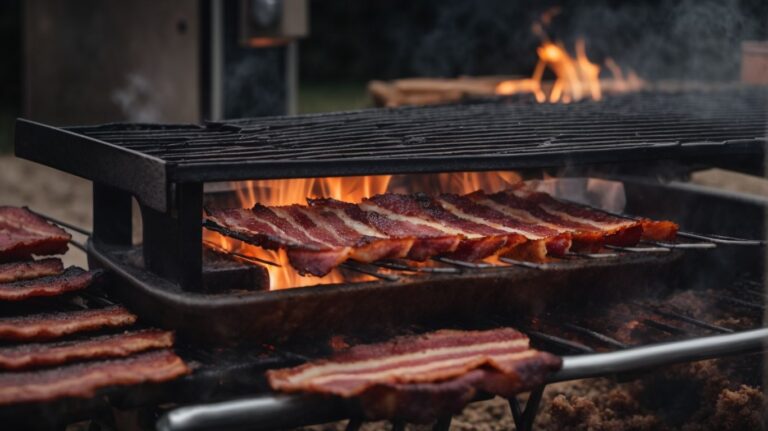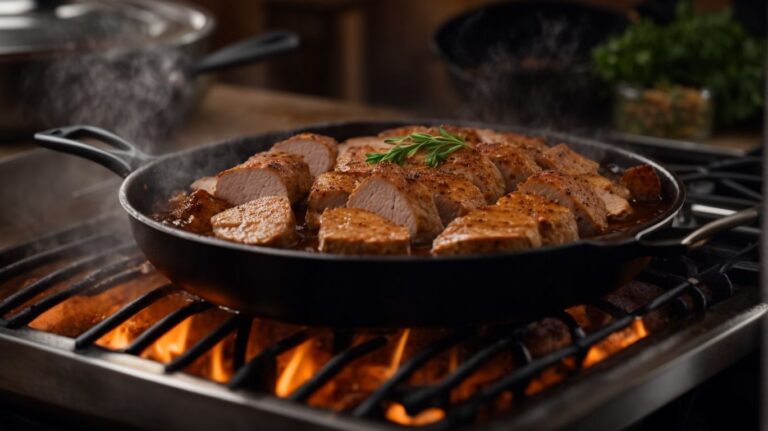How to Cook Crab Legs?
Crab legs are a delicious seafood delicacy that can be enjoyed in a variety of ways.
From different types of crab legs like Snow Crab, King Crab, Dungeness Crab, and Blue Crab, to where to buy them and how to prepare them, there’s a lot to explore.
In this article, we will cover everything you need to know about cooking crab legs, including methods such as boiling, steaming, grilling, and baking.
Stay tuned for seasoning and serving suggestions, as well as tips and tricks for cooking the perfect crab legs.
Key Takeaways:
Types of Crab Legs
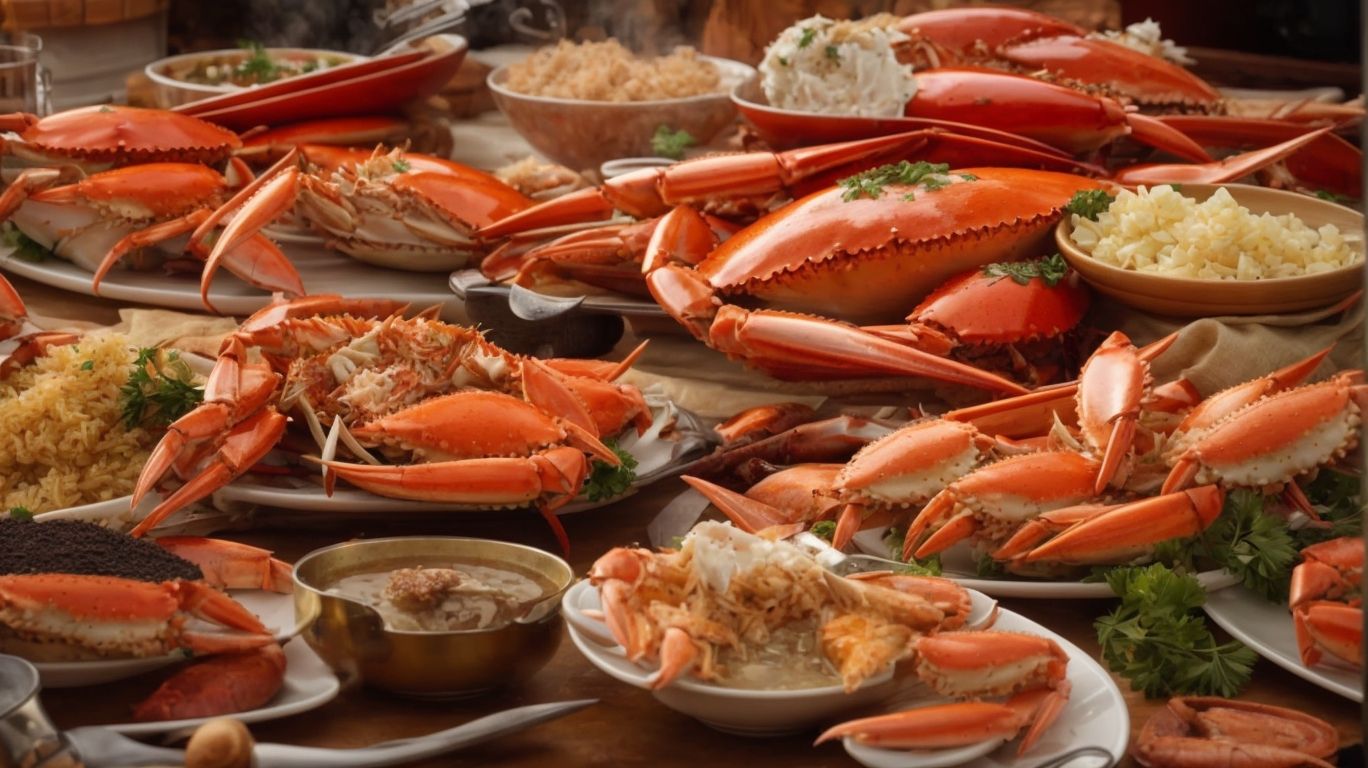
Credits: Poormet.Com – Zachary King
Crab Legs come in various types such as Snow Crab Legs, King Crab Legs, Dungeness Crab Legs, and Blue Crab Legs.
Snow Crab Legs are known for their delicately sweet flavor and tender texture, making them a popular choice for dishes requiring a milder taste. They are commonly used in salads, pasta dishes, and seafood boils. When cooking Snow Crab Legs, steaming or boiling is recommended to maintain their delicate flavor.
On the other hand, King Crab Legs are prized for their rich, buttery taste and firm, succulent meat. They are often enjoyed on their own or as a luxurious addition to seafood platters and sushi rolls. Grilling or baking King Crab Legs enhances their natural sweetness and produces a lovely charred flavor.
Dungeness Crab Legs offer a slightly sweet and briny flavor with a firm texture. They are a favorite for crab cakes, bisques, and seafood stews. Steaming or pan-searing Dungeness Crab Legs helps to preserve their delicate taste and unique texture.
Blue Crab Legs are known for their sweet, delicate flavor and tender meat. They are commonly used in dishes like crab salads, sandwiches, and gumbo. Boiling or sautéing Blue Crab Legs can bring out their natural sweetness and succulence.
Snow Crab Legs
Snow Crab Legs are known for their delicate flavor and tender meat, making them a popular choice among seafood enthusiasts.
In terms of taste, snow crab legs boast a mild and sweet flavor with a hint of brininess, making them versatile for a variety of dishes. These crab legs are often sold frozen, pre-cooked, and ready to heat and serve, making them convenient for home cooks. To ensure you are getting high-quality snow crab legs, look for ones that have a bright, clean shell without any discoloration or off-putting smells.
When it’s time to cook these delicious crab legs, there are several methods you can choose from. You can steam them, boil them, bake them, or even grill them to perfection. Each method offers a unique way to enhance the natural sweetness of the crab meat.
King Crab Legs
King Crab Legs are prized for their sweet, succulent meat and are often served with melted butter and a hint of garlic for a delightful dining experience.
}”
These impressive crustaceans stand out for their colossal size, meaty texture, and rich, buttery flavor. Their distinctive appeal makes them a favorite choice for special occasions and gourmet meals.
When preparing King Crab Legs, it’s crucial to highlight their natural sweetness while enhancing their taste with complementary flavors. A popular recipe involves steaming or boiling the legs until tender, then serving them alongside a decadent mix of melted butter infused with minced garlic. This simple yet exquisite dish allows the delicate flavor of the crab meat to shine through.
}
Dungeness Crab Legs
Dungeness Crab Legs are known for their sweet and slightly nutty flavor, requiring proper cleaning and prepping to preserve their freshness.
These succulent crab legs have a delicate meat that is perfect for a variety of dishes, from simple steamed crab legs to extravagant seafood platters. To clean and prep them, start by running the crab legs under cold water to remove any debris. Next, use kitchen shears to carefully cut open the shells and expose the meat inside.
In terms of fresh versus frozen Dungeness crab legs, fresh ones are superior in taste and texture. Frozen crab legs can lack some of the sweetness and tenderness that fresh ones offer. To store fresh crab legs, keep them in the coldest part of your refrigerator wrapped in damp paper towels. Frozen crab legs should be kept frozen until ready to use, then thawed slowly in the refrigerator overnight.
Blue Crab Legs
Blue Crab Legs offer a sweet and briny taste that shines when grilled or baked, allowing for the flavors to meld beautifully.
When preparing Blue Crab Legs, it’s essential to choose the right seasonings to complement their delicate flavors. Old Bay seasoning is a classic choice that adds a perfect blend of savory and spicy notes to the crab. A simple mixture of melted butter, garlic, and lemon can elevate the natural tastes of the crab meat.
For a creative serving idea, consider arranging the grilled or baked crab legs on a platter with a side of tangy remoulade sauce and a sprinkle of fresh herbs for a restaurant-worthy presentation.
Where to Buy Crab Legs?

Credits: Poormet.Com – Joseph Jackson
When looking to buy crab legs, consider reputable seafood markets or online suppliers that offer fresh and high-quality options to ensure a delectable dining experience.
One key difference between fresh and frozen crab legs is their texture. Fresh crab legs tend to be more tender and succulent, while frozen ones may lose some of their natural juices during the freezing process, resulting in a slightly firmer texture.
When choosing crab legs, pay attention to the aroma – they should have a fresh, sweet smell reminiscent of the sea. Opt for crab legs with a vibrant color and avoid any that appear discolored or have an off-putting odor.
To ensure you’re getting the best quality, aim to purchase crab legs that are relatively thick and heavy for their size, as this indicates a good meat-to-shell ratio and plump, flavorful meat when cooked.”
How to Prepare Crab Legs?
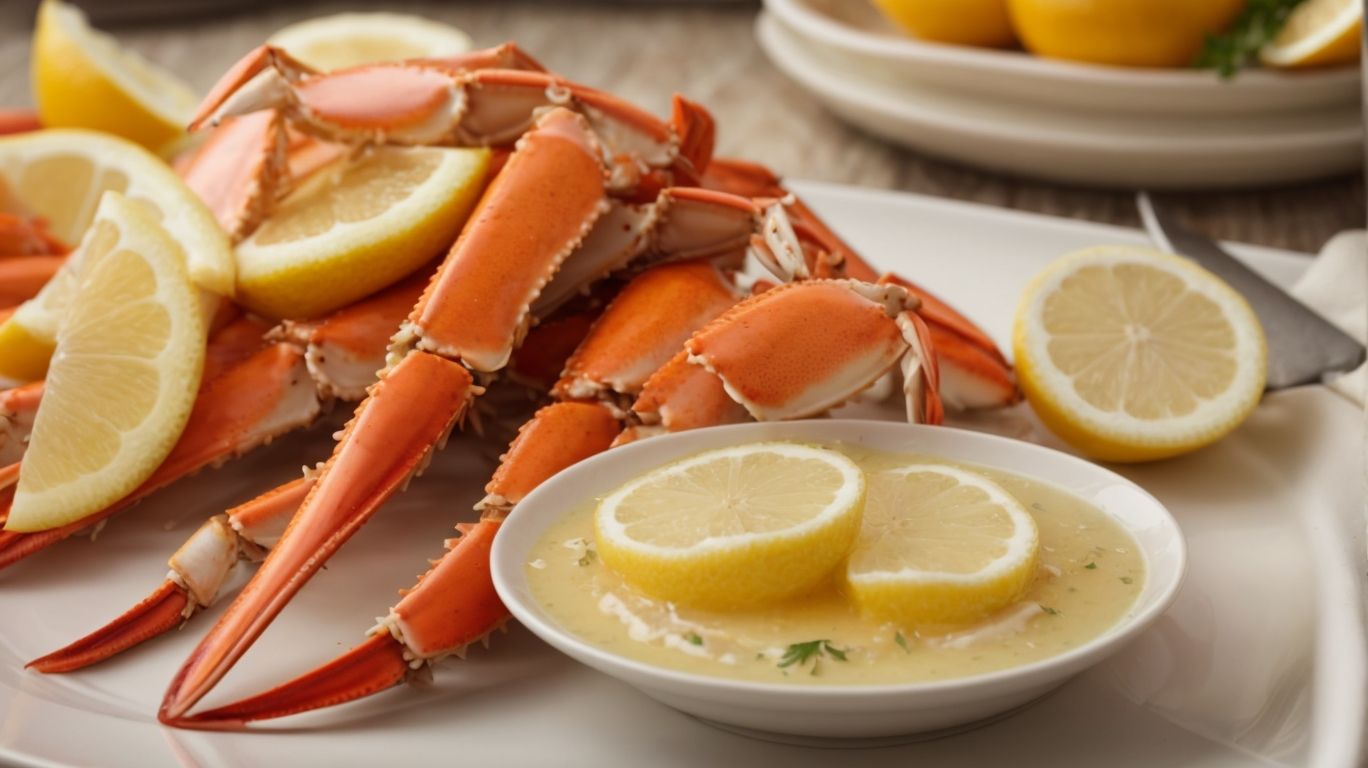
Credits: Poormet.Com – Jesse Anderson
Preparing crab legs involves thawing frozen ones gently and cleaning and prepping fresh ones meticulously to ensure a delicious and satisfying dining experience.
Thawing frozen crab legs properly is crucial to maintain their delicate texture. Start by placing them in the refrigerator overnight or soaking them in cold water for a quicker thaw. Never thaw crab legs in hot water, as this can cause the meat to become tough.
In terms of cleaning fresh crab legs, remove any visible dirt or debris by rinsing them under cold water. Next, use kitchen shears to cut along the length of the shell to expose the meat for cooking. Be sure to remove any innards or the gills before proceeding to your chosen recipe.
Thawing Frozen Crab Legs
Thawing frozen crab legs in the refrigerator slowly is the recommended method to preserve their texture and flavor while ensuring food safety.
Thawing crab legs in the refrigerator allows for a gradual thaw, which helps maintain the delicate taste and texture of the meat. By slowly thawing them, you can prevent any sudden temperature changes that could affect the quality of the crab legs. It is crucial to ensure that the crab legs are stored properly to avoid any contamination. Using airtight containers is a great way to prevent any cross-contamination with other food items in your fridge.
For optimal results, remember to place the crab legs on a plate or in a shallow dish to catch any potential drips or moisture. This will help maintain the cleanliness of your fridge while the crab legs thaw. It’s advisable to check the progress of the thaw periodically. If there are any signs of spoilage or off odors, it’s best to discard them to avoid any health risks.
Cleaning and Prepping Fresh Crab Legs
Cleaning and prepping fresh crab legs involve removing any residual shells and ensuring the meat is ready for cooking, enhancing the dining experience.
To effectively clean fresh crab legs, start by rinsing them under cold water. This step helps remove any debris or dirt that may be on the surface. Next, carefully inspect the legs for any remaining shell remnants. Use a pair of kitchen shears or scissors to trim off any sharp edges or cartilage, ensuring that only the succulent meat is left.
Once the legs are cleaned, it’s essential to properly prep them for cooking. One crucial step is to break the legs at the joints for easier handling and eating. This can be done by gently bending the joints until they crack, allowing for a more enjoyable dining experience without any unwanted parts.
Methods of Cooking Crab Legs
Crab legs can be cooked using various methods such as boiling, steaming, grilling, or baking to bring out their natural sweetness and delicate texture.
When boiling crab legs, start by bringing a large pot of salted water to a boil. Add the crab legs, reduce the heat to a simmer, and cook for about 4-6 minutes until heated through.
For steaming, place a steamer basket over boiling water, arrange the crab legs, cover, and steam for 5-7 minutes.
When grilling, brush the legs with butter and seasonings, then grill for 5-7 minutes per side.
Baking involves placing the legs on a baking sheet, brushing with butter, and baking at 375°F for around 10-12 minutes.
Boiling Crab Legs
Boiling crab legs in a pot of seasoned water is a classic method that infuses the meat with flavor while maintaining its succulence.
To start, fill a large pot with enough water to fully submerge the crab legs. Add a generous amount of sea salt to the water to mimic the natural salinity of the ocean, enhancing the taste of the crab meat.
Bring the water to a rolling boil over high heat. Once boiling, gently place the crab legs into the pot using tongs to avoid splashing hot water. The crab legs should be fully immersed in the boiling water for even cooking.
Let the crab legs simmer in the seasoned water for about 6-8 minutes, ensuring they are cooked through but not overdone. Check the shells for a bright, vibrant color, indicating they are ready to be served.
Steaming Crab Legs
Steaming crab legs with lemon wedges creates a fragrant aroma that enhances the natural seafood flavors, resulting in a light and delightful dish.
To begin the steaming process, fill a large pot with water and bring it to a boil. Add lemon wedges to the water to infuse the crab legs with a subtle citrus undertone as they cook. Once the water is simmering, place a steaming basket or rack over the pot, ensuring that it doesn’t touch the water. This gentle cooking method helps preserve the delicate texture of the crab legs, preventing them from becoming tough or rubbery during cooking. Steaming keeps the crab legs moist, locking in their natural juices and flavors for a succulent dining experience.
Grilling Crab Legs
Grilling crab legs imparts a smoky char and a unique flavor profile, providing a delightful alternative to traditional cooking methods.
When grilling crab legs, start by preheating your grill to medium-high heat to achieve that perfect char. Next, prepare the crab legs by brushing them with a mixture of melted butter, minced garlic, a squeeze of lemon juice, and a sprinkle of Old Bay seasoning for a classic seafood flavor. Place the crab legs on the grill and cook for about 5-6 minutes per side, until they are heated through and have beautiful grill marks.
To enhance the grilled crab legs, consider serving them with a variety of dipping sauces. A garlic butter sauce adds richness, while a tangy lemon herb aioli provides a refreshing contrast. For those who like a bit of heat, a spicy chipotle mayo can be a flavorful choice.
Baking Crab Legs
Baking crab legs with a luscious butter sauce results in a succulent and flavorful dish that is easy to prepare and perfect for family traditions.
Preheat your oven to 375°F (190°C) and prepare a baking dish large enough to accommodate the crab legs in a single layer. Next, brush the crab legs with melted butter, ensuring each piece is evenly coated to enhance the flavors during baking.
Place the crab legs in the baking dish and cover it tightly with aluminum foil to seal in the moisture and prevent the meat from drying out. Bake for about 20-25 minutes until the crab meat is heated through and tender.
When storing leftover baked crab legs, ensure they are completely cooled before refrigerating. Place them in an airtight container or wrap them tightly in foil to maintain their freshness. Stored properly, leftover baked crab legs can last in the refrigerator for up to 2-3 days while still retaining their delicious flavors.
Seasoning and Serving Suggestions for Crab Legs
Enhance the flavor of crab legs with a variety of seasoning and serving options, such as classic butter sauce, lemon garlic butter sauce, Cajun seasoning, and Old Bay seasoning.
For a classic butter sauce, melt butter in a saucepan, add minced garlic, a splash of lemon juice, and parsley. Drizzle this velvety sauce over your steamed crab legs, creating a rich and indulgent taste.
If you prefer a tangy kick, the lemon garlic butter sauce is a perfect choice. To make it, blend butter, minced garlic, lemon zest, and a pinch of red pepper flakes.
For a spicier twist, try the Cajun seasoning. Rub a mixture of paprika, garlic powder, onion powder, cayenne pepper, oregano, and thyme onto the crab legs before broiling or grilling them for a fiery flavor profile.
Classic Butter Sauce
Classic butter sauce is a timeless pairing for crab legs, adding richness and flavor to each bite, making the dining experience truly delightful.
The velvety texture of the butter sauce enhances the sweet and delicate taste of the crab meat, creating a harmonious blend of flavors that dance on your palate. Preparing this sauce is a simple process that requires only a few basic ingredients – butter, garlic, lemon juice, and fresh herbs like parsley or chives.”
To serve this exquisite dish, start by laying out a set of crab crackers and small forks to make the dining experience effortless for your guests.
To enjoy the crab legs with the butter sauce, simply crack open the shells with the crackers, dip the juicy meat into the luscious sauce, and savor each bite with a hint of lemony freshness.
Whether you are hosting a fancy dinner party or enjoying a cozy night in, crab legs with classic butter sauce are sure to impress and satisfy your taste buds.”
Lemon Garlic Butter Sauce
Lemon garlic butter sauce elevates the flavor of crab legs with zesty citrus notes and aromatic garlic, creating a mouthwatering experience that delights the senses.
To prepare this delectable sauce, start by melting butter in a saucepan over low heat. Then, add minced garlic to infuse the butter with its rich flavor. Squeeze fresh lemon juice into the mixture, giving it a tangy kick. Stir the ingredients gently, allowing them to blend together harmoniously. As the sauce simmers, the flavors intensify, creating a luxurious base for dipping succulent crab meat. The burst of freshness from the lemon complements the richness of the butter, while the garlic adds a depth of savory goodness. This luxurious sauce takes your crab leg dining experience to a whole new level.
Cajun Seasoning
Cajun seasoning adds a bold and spicy kick to crab legs, infusing them with a distinct flavor profile that appeals to lovers of seafood with a fiery twist.
When preparing Cajun-seasoned crab legs, consider serving them alongside a refreshing side of lemon butter sauce to balance out the heat with a hint of citrusy richness.
Another fantastic accompaniment is a creamy avocado and corn salad, offering a cool contrast to the spicy seasoning.
For a complete meal experience, pair the crab legs with a side of garlic butter roasted potatoes or a zesty cilantro-lime rice. These pairings elevate the bold flavors of Cajun seasoning while enhancing the sweet succulence of the crab meat.
Old Bay Seasoning
Old Bay seasoning is a classic choice for enhancing crab legs, offering a blend of savory spices that complement the tender meat of clusters and claws.
Known for its distinctive blend of herbs and spices, Old Bay seasoning brings a burst of flavor to crab legs like no other. The combination of paprika, celery salt, mustard, and more creates a deliciously complex taste that perfectly marries with the sweet and delicate crab meat. Old Bay seasoning not only adds a rich, savory flavor but also a hint of zesty tanginess that elevates the overall dining experience.
In terms of serving crab legs with Old Bay seasoning, the options are endless. Whether you prefer steamed, boiled, grilled, or baked crab legs, a generous sprinkle of this iconic seasoning is all you need to take your dish to the next level. For a classic Maryland-style feast, simply toss your crab legs in a mix of melted butter and Old Bay seasoning before serving hot.
For a more adventurous twist, try creating a flavorful Old Bay seasoning dip by blending it with mayonnaise, lemon juice, and a touch of hot sauce. This creamy dip pairs perfectly with both the succulent clusters and the meaty claws of crab legs, enhancing every bite with a burst of delicious flavor.
Tips and Tricks for Cooking the Perfect Crab Legs
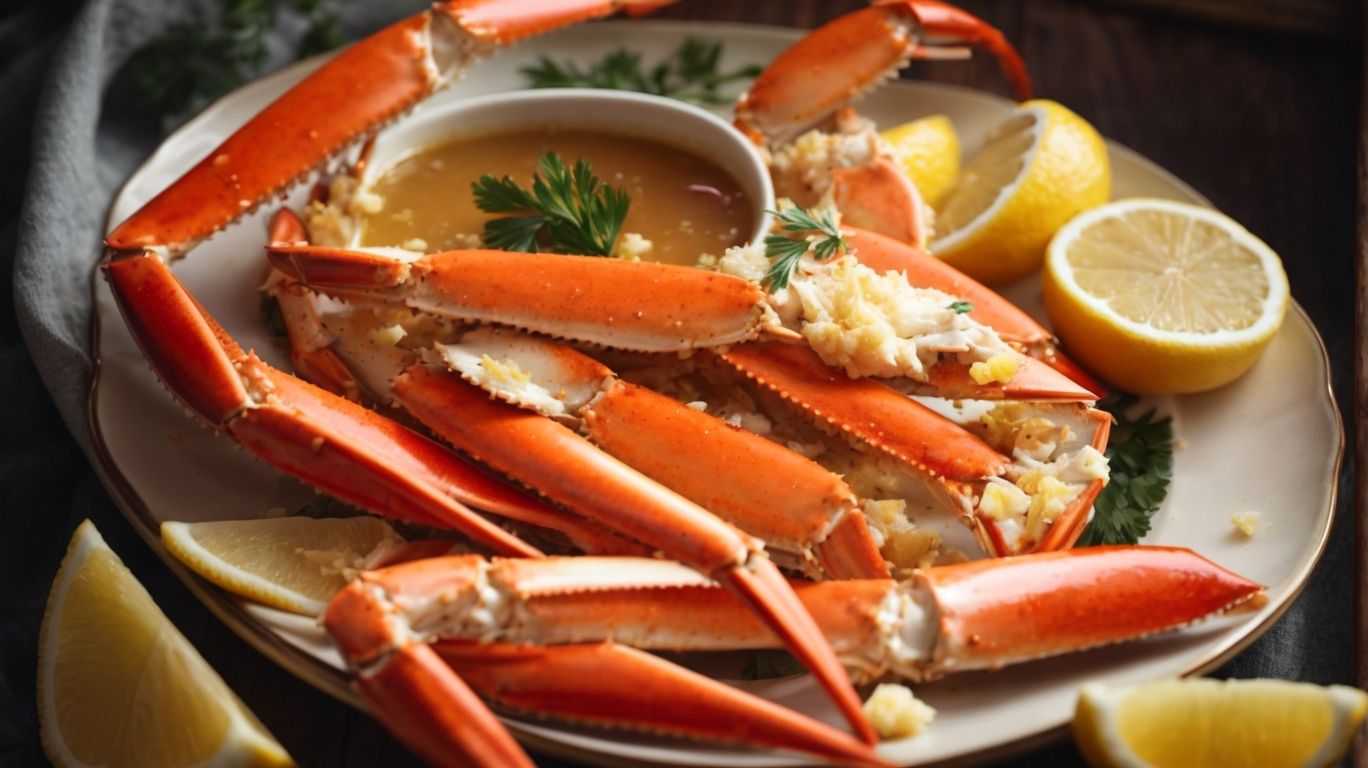
Credits: Poormet.Com – Christopher Perez
Master the art of cooking the perfect crab legs with expert tips and tricks that make the process easy, delicious, and a delightful family tradition.
One key aspect to keep in mind when cooking crab legs is to ensure they are fully thawed if using frozen ones. Placing them in the refrigerator the night before cooking is the ideal way to defrost them slowly. This not only maintains the meat’s quality but also helps with even cooking. In terms of seasoning, a simple mix of melted butter, garlic, lemon, and a sprinkle of Old Bay seasoning can elevate the flavor profile.
For those who prefer a healthier option, steaming crab legs is a great alternative to boiling. Steaming helps retain more of the natural flavors and moisture of the crab meat. To troubleshoot overcooked crab legs, try reducing the cooking time slightly and checking for doneness frequently. Once cooked, leftover crab legs can be stored in an airtight container in the fridge for up to 2 days, but it’s best to consume them fresh for optimal taste.
Frequently Asked Questions
What are the best ways to cook crab legs?
The most popular ways to cook crab legs are steaming, boiling, grilling, and baking. Each method has its own unique benefits, so choose the one that best suits your preferences.
How long should I cook crab legs?
The cooking time for crab legs depends on the method you use. Generally, steaming and boiling take around 5-7 minutes, while grilling and baking may take 10-12 minutes. However, it’s always best to follow a specific recipe for accurate cooking times.
Do I need to thaw crab legs before cooking?
If you have frozen crab legs, it’s recommended to thaw them before cooking. You can thaw them in the refrigerator overnight or place them in a sealed plastic bag and submerge them in cold water for 30 minutes to an hour.
What is the best way to season crab legs?
Crab legs have a delicate flavor, so it’s important not to overpower them with strong seasonings. Simple seasonings like butter, garlic, lemon juice, and Old Bay seasoning are popular choices. Remember to brush the seasoning onto the crab legs before or during the cooking process for best results.
How can I tell when crab legs are done?
The easiest way to tell when crab legs are done is by checking if the meat is opaque and white. You can also use a meat thermometer to check the internal temperature, which should be 145°F (63°C) for cooked crab legs.
Can I reuse leftover crab legs?
Yes, leftover crab legs can be refrigerated and reheated for another meal. However, it’s important to properly store and reheat them to avoid the risk of foodborne illness. You can also use leftover crab meat in recipes like crab cakes or dips.





